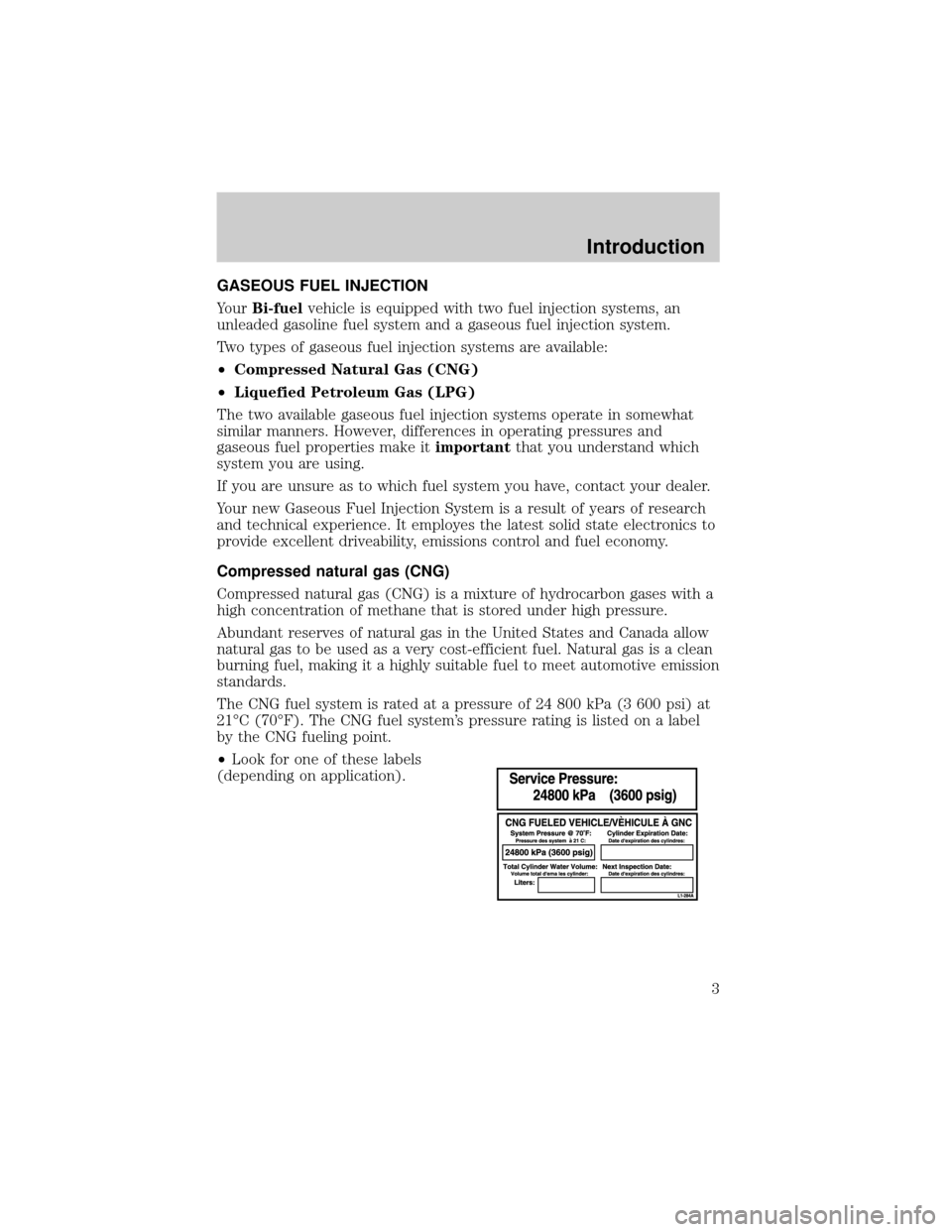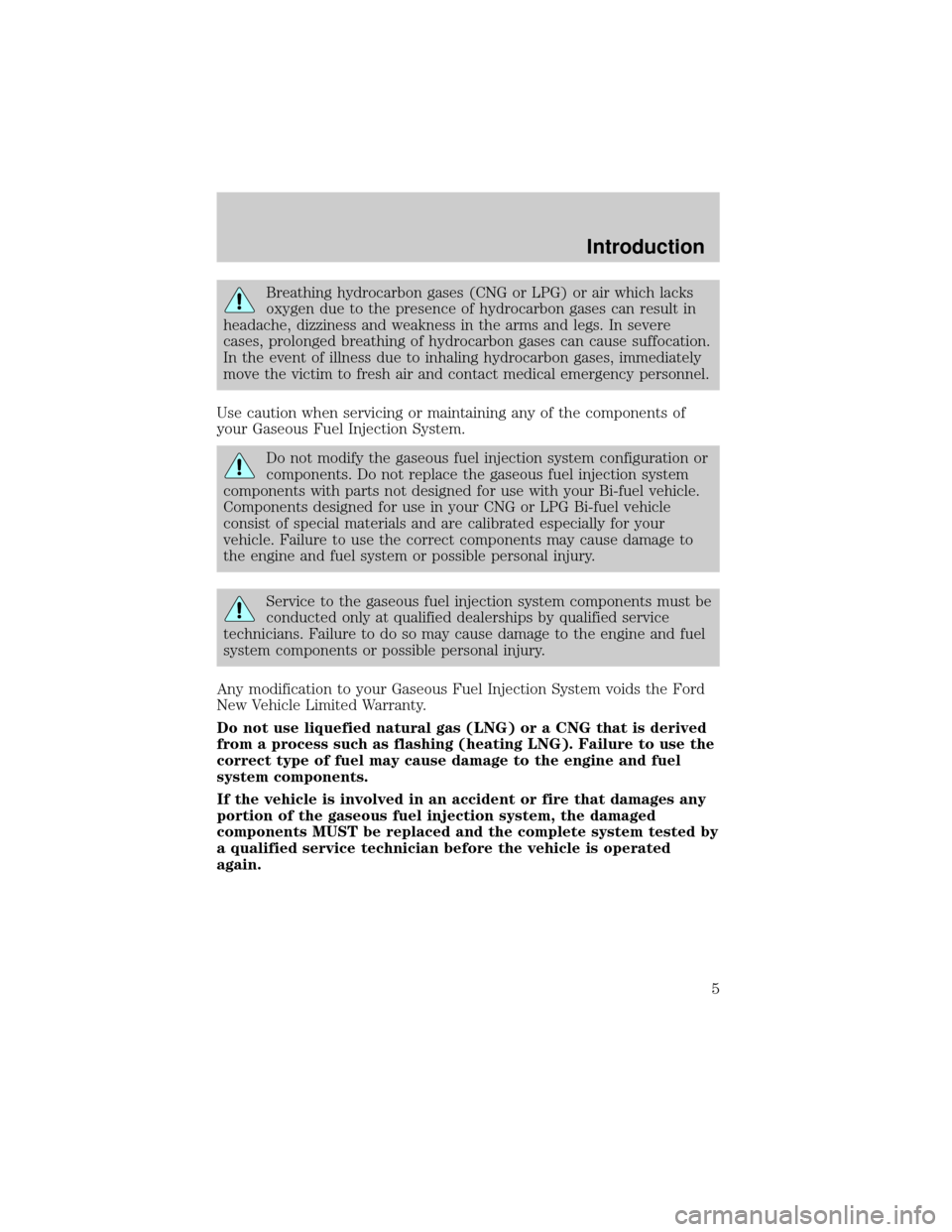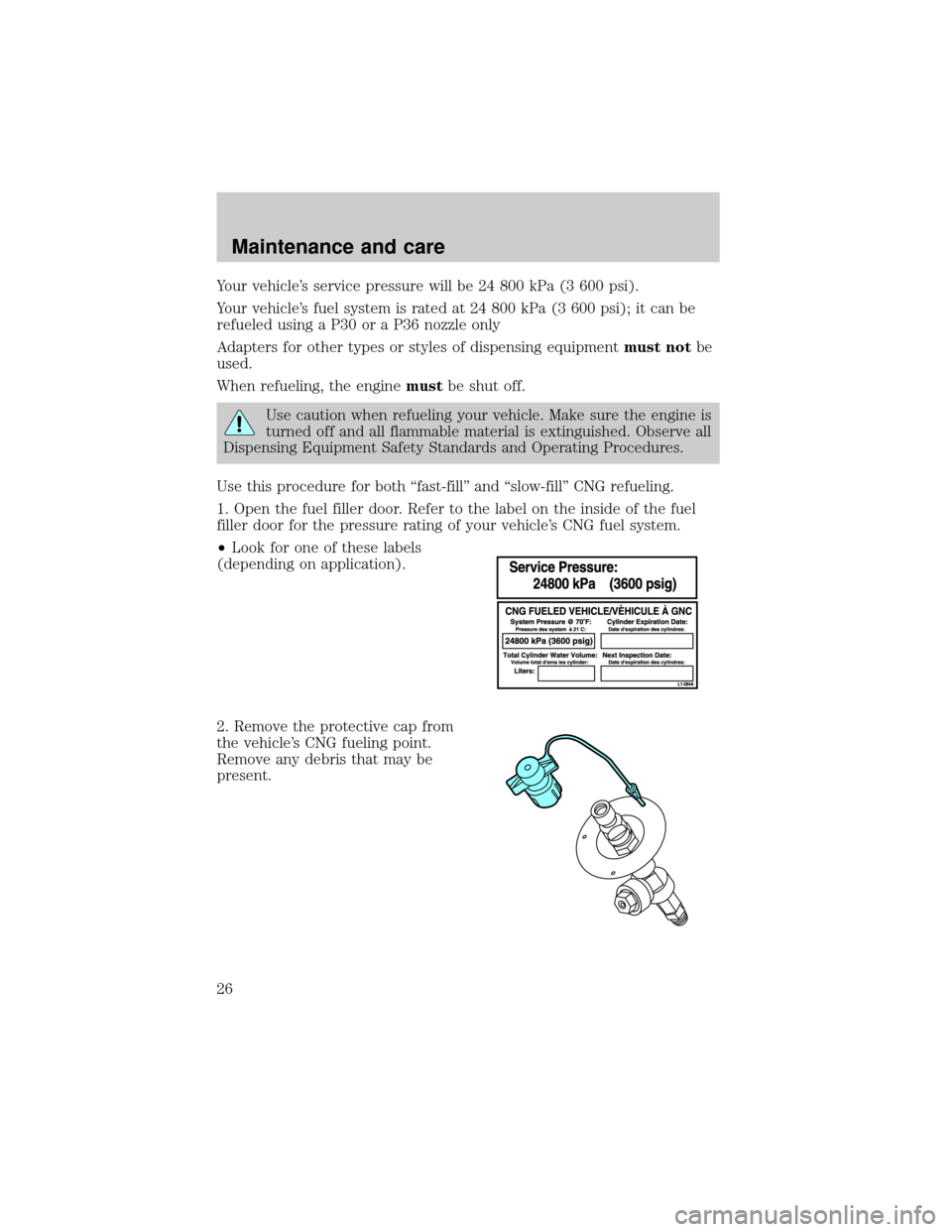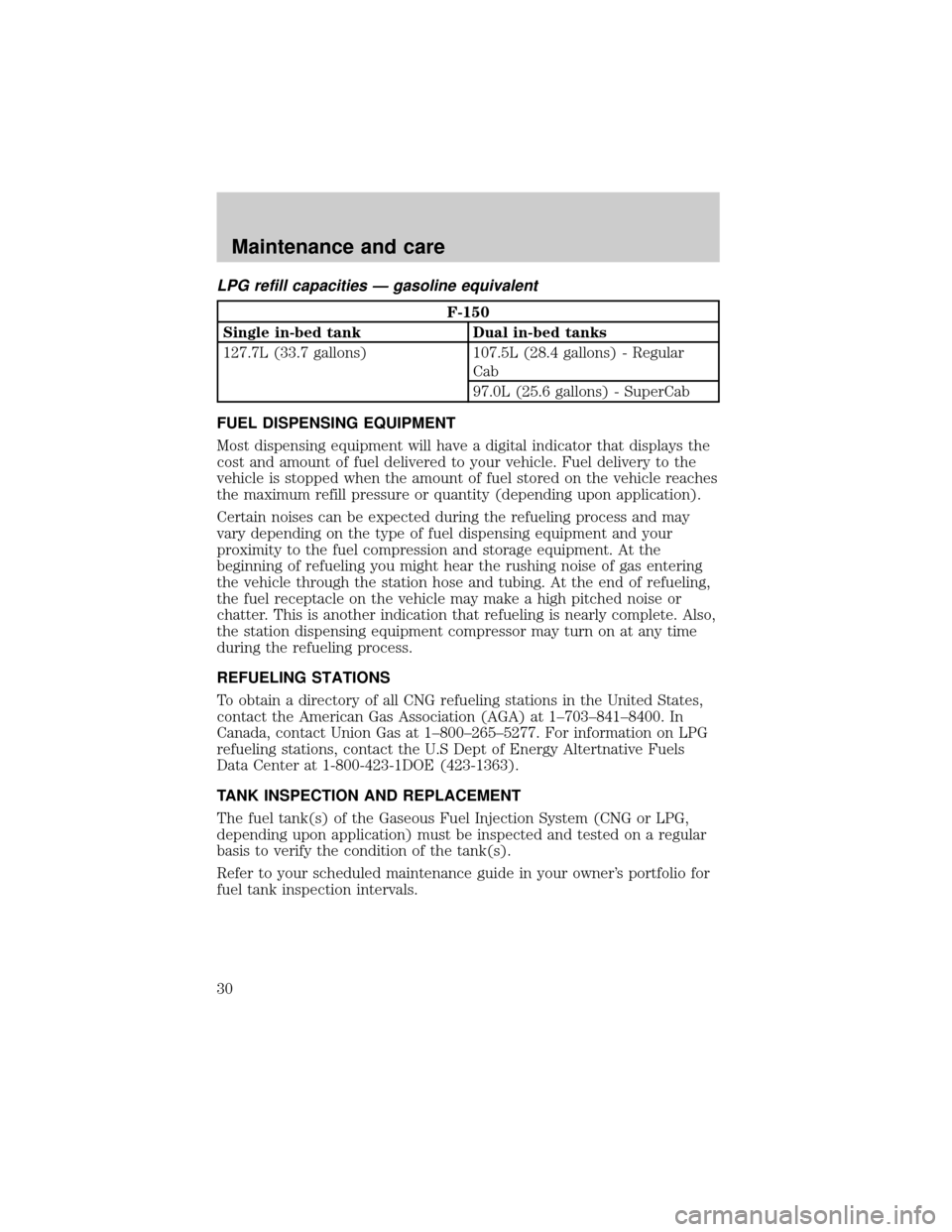2002 FORD F150 fuel type
[x] Cancel search: fuel typePage 3 of 32

GASEOUS FUEL INJECTION
YourBi-fuelvehicle is equipped with two fuel injection systems, an
unleaded gasoline fuel system and a gaseous fuel injection system.
Two types of gaseous fuel injection systems are available:
²Compressed Natural Gas (CNG)
²Liquefied Petroleum Gas (LPG)
The two available gaseous fuel injection systems operate in somewhat
similar manners. However, differences in operating pressures and
gaseous fuel properties make itimportantthat you understand which
system you are using.
If you are unsure as to which fuel system you have, contact your dealer.
Your new Gaseous Fuel Injection System is a result of years of research
and technical experience. It employes the latest solid state electronics to
provide excellent driveability, emissions control and fuel economy.
Compressed natural gas (CNG)
Compressed natural gas (CNG) is a mixture of hydrocarbon gases with a
high concentration of methane that is stored under high pressure.
Abundant reserves of natural gas in the United States and Canada allow
natural gas to be used as a very cost-efficient fuel. Natural gas is a clean
burning fuel, making it a highly suitable fuel to meet automotive emission
standards.
The CNG fuel system is rated at a pressure of 24 800 kPa (3 600 psi) at
21ÉC (70ÉF). The CNG fuel system's pressure rating is listed on a label
by the CNG fueling point.
²Look for one of these labels
(depending on application).
Introduction
3
Page 5 of 32

Breathing hydrocarbon gases (CNG or LPG) or air which lacks
oxygen due to the presence of hydrocarbon gases can result in
headache, dizziness and weakness in the arms and legs. In severe
cases, prolonged breathing of hydrocarbon gases can cause suffocation.
In the event of illness due to inhaling hydrocarbon gases, immediately
move the victim to fresh air and contact medical emergency personnel.
Use caution when servicing or maintaining any of the components of
your Gaseous Fuel Injection System.
Do not modify the gaseous fuel injection system configuration or
components. Do not replace the gaseous fuel injection system
components with parts not designed for use with your Bi-fuel vehicle.
Components designed for use in your CNG or LPG Bi-fuel vehicle
consist of special materials and are calibrated especially for your
vehicle. Failure to use the correct components may cause damage to
the engine and fuel system or possible personal injury.
Service to the gaseous fuel injection system components must be
conducted only at qualified dealerships by qualified service
technicians. Failure to do so may cause damage to the engine and fuel
system components or possible personal injury.
Any modification to your Gaseous Fuel Injection System voids the Ford
New Vehicle Limited Warranty.
Do not use liquefied natural gas (LNG) or a CNG that is derived
from a process such as flashing (heating LNG). Failure to use the
correct type of fuel may cause damage to the engine and fuel
system components.
If the vehicle is involved in an accident or fire that damages any
portion of the gaseous fuel injection system, the damaged
components MUST be replaced and the complete system tested by
a qualified service technician before the vehicle is operated
again.
Introduction
5
Page 14 of 32

When the selector switch is placed
in the GAS position, your engine will
operate in the unleaded gasoline
mode.
If the CNG or LPG (depending upon application) runs low during the
operation of the vehicle in the gaseous fuel mode, the gaseous fuel
injection system will automatically change to the unleaded gasoline
operating mode. The green indicator light on the fuel selector switch will
turn off to show the vehicle has changed to the unleaded gasoline
operating mode.
The vehicle's fuel system will NOT automatically change to the
gaseous fuel mode (CNG or LPG, depending upon application),
if the level of the unleaded gasoline runs low.
FUEL GAUGE
The fuel gauge in your CNG or LPGBi-fuelvehicle (depending upon
application) behaves similarly to a standard gasoline fuel gauge. The fuel
gauge will provide a linear reading from Full down to Empty.
²Fuel gauge operation for aLPG Bi-fuelvehicle is based on a float
type sensor measuring the level of the liquid propane in the fuel
tank(s).
²Fuel gauge operation for aCNG Bi-fuelvehicle is based on the
pressure and temperature of the natural gas in the fuel tank(s).
Depending upon the application, a full fuel gauge reading will occur at
a pressure of approximately 20 700 kPa (3 000 psi) or 24 800 kPa
(3 600 psi) at a temperature of approximately 21ÉC (70ÉF). For more
information on fuel gauge performance during the fast-fill method of
CNG fueling, refer toRefueling your Bi-fuel vehiclein the
Maintenance and carechapter of this supplement.
ALT
GAS
Instrumentation and controls
14
Page 26 of 32

Your vehicle's service pressure will be 24 800 kPa (3 600 psi).
Your vehicle's fuel system is rated at 24 800 kPa (3 600 psi); it can be
refueled using a P30 or a P36 nozzle only
Adapters for other types or styles of dispensing equipmentmust notbe
used.
When refueling, the enginemustbe shut off.
Use caution when refueling your vehicle. Make sure the engine is
turned off and all flammable material is extinguished. Observe all
Dispensing Equipment Safety Standards and Operating Procedures.
Use this procedure for both ªfast-fillº and ªslow-fillº CNG refueling.
1. Open the fuel filler door. Refer to the label on the inside of the fuel
filler door for the pressure rating of your vehicle's CNG fuel system.
²Look for one of these labels
(depending on application).
2. Remove the protective cap from
the vehicle's CNG fueling point.
Remove any debris that may be
present.
Maintenance and care
26
Page 30 of 32

LPG refill capacities Ð gasoline equivalent
F-150
Single in-bed tank Dual in-bed tanks
127.7L (33.7 gallons) 107.5L (28.4 gallons) - Regular
Cab
97.0L (25.6 gallons) - SuperCab
FUEL DISPENSING EQUIPMENT
Most dispensing equipment will have a digital indicator that displays the
cost and amount of fuel delivered to your vehicle. Fuel delivery to the
vehicle is stopped when the amount of fuel stored on the vehicle reaches
the maximum refill pressure or quantity (depending upon application).
Certain noises can be expected during the refueling process and may
vary depending on the type of fuel dispensing equipment and your
proximity to the fuel compression and storage equipment. At the
beginning of refueling you might hear the rushing noise of gas entering
the vehicle through the station hose and tubing. At the end of refueling,
the fuel receptacle on the vehicle may make a high pitched noise or
chatter. This is another indication that refueling is nearly complete. Also,
the station dispensing equipment compressor may turn on at any time
during the refueling process.
REFUELING STATIONS
To obtain a directory of all CNG refueling stations in the United States,
contact the American Gas Association (AGA) at 1±703±841±8400. In
Canada, contact Union Gas at 1±800±265±5277. For information on LPG
refueling stations, contact the U.S Dept of Energy Altertnative Fuels
Data Center at 1-800-423-1DOE (423-1363).
TANK INSPECTION AND REPLACEMENT
The fuel tank(s) of the Gaseous Fuel Injection System (CNG or LPG,
depending upon application) must be inspected and tested on a regular
basis to verify the condition of the tank(s).
Refer to your scheduled maintenance guide in your owner's portfolio for
fuel tank inspection intervals.
Maintenance and care
30